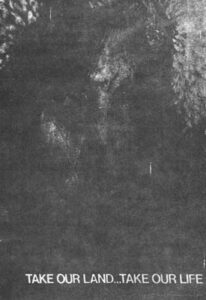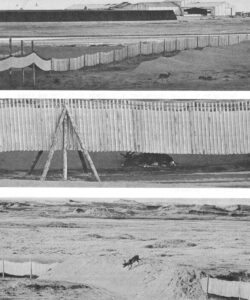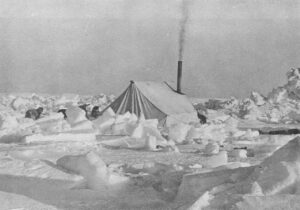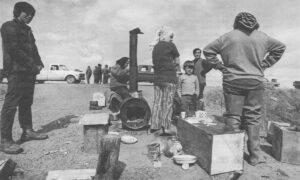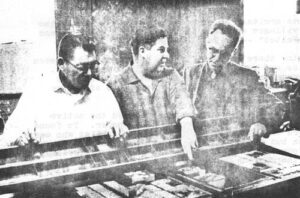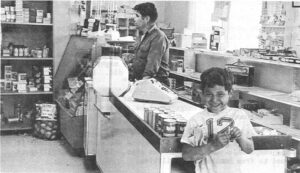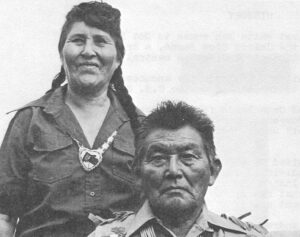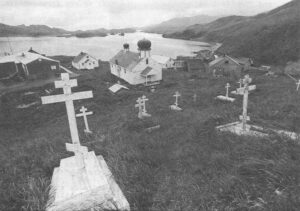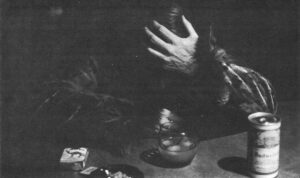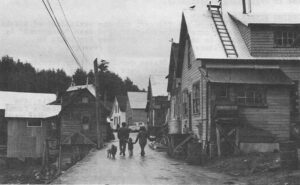January 31, 1972
Preparations for the Alicia Patterson Fund Sub-Polar Expedition (APFSE) have been long, laborious and a trifle unnerving. At destination Anaktuvuk Pass the chill factor ranges from -20º to -80º which could be the makings of a fast-frozen “fellow.”
There’s something delightfully ludicrous, though, about being an expedition of one, and female, to boot.
It started in Seattle at Jim Whittaker’s. His shop has the deceiving name of “Recreational Equipment” but he caters to Mt. Everest and McKinley expeditions and Alaskan VISTA volunteer types.
I arrived with a covey of Seattle matrons who’d come to outfit their young with beginner skis. The only thing that made me stand out in a crowd like that was my demand for an Arctic expert.
Someone sent me to John Sherpa in the boot department. He’d spent several months at the North Pole, was a climber, a native of Nepal and just the man.
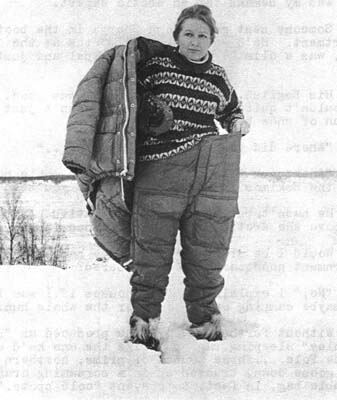
His English, though unorthodox, was good, but he couldn’t quite grasp the idea I wasn’t just in search of snow boots for junior.
“Where did you say you were going….”
“Anaktuvuk Pass for a month, then whale hunting with the Eskimos in Point Hope. Have you been there?”
He hadn’t, but he checked the latitude and found it above the Arctic Circle and decided it was serious.
Would I be sleeping in an Army barracks or government headquarters, he wondered?
“No,” I explained. “Sod houses if I was lucky and maybe camping on the ice for the whale hunt.”
Without further question he produced an “Expedition McKinley” sleeping bag just like the one he’d used at the Pole…three pounds of prime, northern silver grey goose down, trussed up in a screaming orange bag. A double bag, in fact, to prevent “cold spots.”
He recommended blue,feather booties and red thermal socks. The latter would be especially useful, he suggested, if I fell head first in the snow. Easy to spot, providing I could wiggle my boots off.
He brought out red gloves, too; down filled with fur backs to warm your nose. Sherpa was pretty enthuiastic about this feature. Demonstrated it a couple of times, burrowing his handsome nose in the soft fur.
Then he took a sceptical look at their Expedition down parka. It had served the International Himalayan Expedition, the American Antarctic Expedition and probably Bobby Kennedy in his climb up Mt. Kennedy, but would it serve APFSE?
“We have just made a better parka,” he said. “It’s not in production yet but we have a sample. It’s really good and I think it would fit you.”
It did, as much as any of the men’s sizes fit me; billowing just above my knees, sleeves over finger tips, a welter of feathers bulging under bright blue nylon. If it didn’t take off and fly south on its own, it should be a warm investment.
So would the down pants. The smallest size was built for a man just my height who weighed 38O pounds. Bright red.
Sherpa decided it was perfect and which did I want, Vogue and frostbight or multicolored bulges and survival?
Frostbight is forever.
“Is she an expedition?” the cashier asked.
“You might say that,” Sherpa answered.
Survival by Book
In Anchorage, Keith Arnold presented me with the “Cold Weather Operations Survival” book he did for the Alaska Oil and Gas Assn.
It’s waterproof, won’t rip and won’t burn, he assured me proudly. Great, I’ll read it at -60º while I’m freezing for want of kindling.
Not a cheerful book, this. The chill factor page warns that at -25º with a 15 mile-an-hour wind, flesh may freeze within one minute. At -75º with a 10 mile wind it takes only 30 seconds.
For treatment of superficial frostbite in the field, “Cover cheeks with warm hands until pain returns.”
Layers of clothing are recommended to trap warm air and personal hygiene is stressed.
“Bathe as frequently as conditions will permit,” which will be just before I go to Anaktuvuk Pass and just after I return a month later. The old trappers and natives regard a bath in the Arctic winter as a weird form of suicide.
But the book deals with this philosophy, too.
“While extreme cold does not kill lice, it paralyzes them; therefore garments should be hung in the cold, then beaten and brushed.”
There’s a fine chapter on first aid. So explicit in dealing with frostbite, trenchfoot and snowblindness, it pained me to read it. I tucked it in my parka pocket to read on those happy occasions.
Then on to Fairbanks for final preparation. A snowmobile driver had just been rescued from an overnight at -85º. Came through with just a touch of frostbight on wrists and ankles. So I bought snowmobile boots.
A less successful purchase was a spiffy snowmobile jumpsuit. It crackled and rattled so in the cold it sounded like the sleeves would fall out. And how, asked a friend, would you answer a call of nature with only a zipper down the front? Take off the whole top?
Howard Rock, Eskimo editor of the Tundra Times, does not approve of any of my man-made gear. I should wear fur. I agree but fur takes time to tailor and costs several hundred dollars more.
“Well, the Eskimos will worry about you,” he assured me. He loaned me his beautiful fur seal mittens. He worries.
A friend from California sent a wool face mask with a little pompon on top. It may look silly, but no one can tell who you are. And it’s warmer than anything I’ve seen here.
Another friend insists I buy glasses against snowblindness.
Word comes from Anaktuvuk that the store is out of groceries. A month’s shopping is in order.
A friend of a friend in Anaktuvuk writes triumphantly he has rented me a house for $30 a month. Of course, fuel is $75 a barrel and I’ll probably have to roll my own barrel from the airport, but at least they’ve got some. Last winter they ran out.
And finally arrangements are complete. I leave in the morning.
My special camera from Bell and Howell just arrived.
“It and the lenses have been tested at temperatures as low as -65º,” writes Mike Laurance of their consumer products group. “Everything works just fine.”
Now to test the photographer and APFSE at -65º. That report will follow next month (I hope.).
Received in New York on February 3, 1972.
©1972 Lael Morgan
Lael Morgan is an Alicia Patterson Fund Fellow on leave from the Tundra Times (Fairbanks, Alaska). This article may be published with credit to Mrs. Morgan, the Tundra Times, and the Alicia Patterson Fund.


